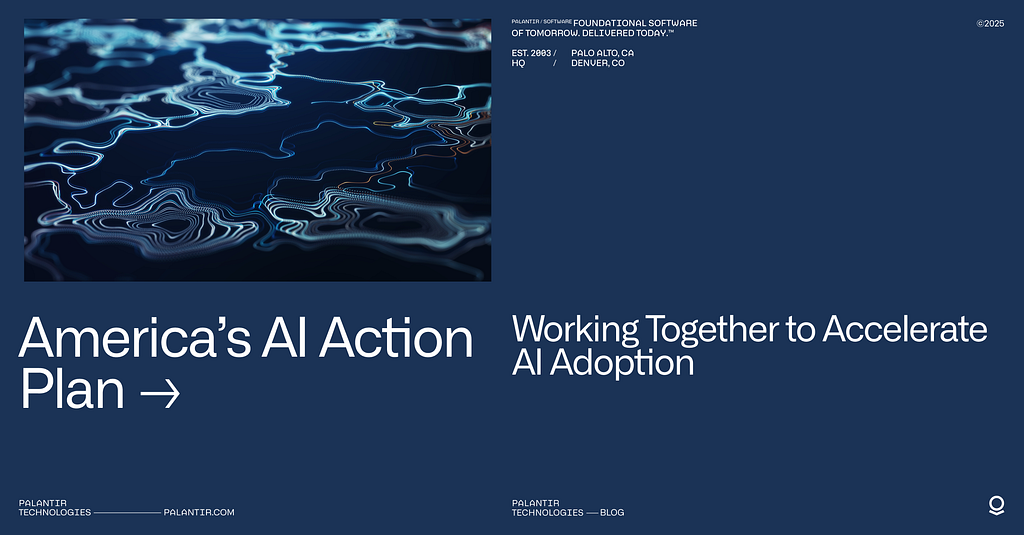Working Together to Accelerate AI Adoption

On July 23, 2025, the White House unveiled “Winning the AI Race: America’s AI Action Plan,” a bold roadmap to secure US leadership in artificial intelligence by driving innovation, building new critical infrastructure, and refocusing global diplomacy. This much-needed plan, backed by President Trump’s executive orders, outlines over 90 federal policy actions to remove bureaucratic barriers, promote open-source AI models, and streamline adoption across federal agencies, with a strong focus on the Department of Defense (DoD) and other key agencies.
Palantir is proud that the substance of so many of our recommendations to the White House helped shape the final plan. Combined with existing executive orders, these measures provide a compelling path forward for operationalizing AI at scale. By expanding proven platforms and reimagining testbeds as catalysts for rapid deployment, the United States can solidify its position as the global leader in AI.
Commercial Item Preference in Federal Procurement
The AI Action Plan’s emphasis on commercial item preference in federal procurement, particularly at the DoD, is a pragmatic and commendable step. By encouraging agencies to leverage private sector innovation and prioritize commercially available AI solutions, federal agencies can bypass lengthy development cycles and rapidly adopt cutting-edge technologies that address mission-critical needs and requirements, on time and within budget.
To fully align with this plan, agencies like Defense and Homeland Security should begin by streamlining their internal Authority to Operate (ATO) process for AI systems. This could involve developing clear AI system guidelines for security and effectiveness assessments, leveraging robust testing and evaluation infrastructure and frameworks, and adopting a risk-based approach to ATO approvals. Expanding the use of Other Transaction Authorities (OTAs) for AI procurement would provide a fair, flexible, and efficient mechanism for procuring cutting-edge technologies from non-traditional vendors, while still ensuring appropriate degrees of transparency and public accountability.
Leveraging Existing Operational Platforms
Agencies should note there are existing, proven platforms already in use that can be expanded, allowing for a far more efficient adoption of new technologies. The National Geospatial-Intelligence Agency’s Maven Smart System and Army Vantage, both powered by Palantir platforms, support warfighters with real-time, actionable data. The Maven Smart System delivers enhanced intelligence analysis to combatant commands through Palantir’s Artificial Intelligence Platform (AIP), leveraging large language models (LLMs) and machine learning. Vantage, the Army’s data-driven analytics platform for decision-making, is one of the largest Foundry deployments to the US Government and helps to ensure optimal force readiness. Elsewhere, Palantir’s software is used to help fight forest fires and ensure energy grids are maintained and back online following disasters.
Importantly, any government agency interested in leveraging the tooling in these platforms would require its own dedicated instance, with data environments that are licensed and completely distinct for each customer.
These platforms are not theoretical — they are operational today. Their scalable architecture supports a wide array of AI applications, from projects built with Palantir AIP to integration with external models and startups through the OpenDAGIR program. Once integrated, they are ready for experimentation, testing, and ultimately real-world deployment (subject to compliance and approval processes).
The Action Plan’s call for “regulatory sandboxes” and AI Centers of Excellence should prioritize scaling these platforms and others like them.
The Expanding Role of AI Testbeds
The AI Action Plan’s emphasis on testbeds is a forward-thinking recommendation, one that Palantir included in our response to the Action Plan’s initial RFI. The capacity of testbeds extends beyond evaluation alone. While critical for evaluating the efficacy of new systems, their true value is in enabling a more streamlined path to AI deployment. By integrating standards — such as those the National Institute of Standards and Technology (NIST) is responsible for delivering as part of the AI Action Plan — into testbed environments, new AI systems can be prototyped, validated, and deployed in secure, controlled settings that accurately simulate real-world conditions. This approach reduces risk while accelerating the transition from concept to operation.
We recommend that the Center for AI Standards and Innovation (CAISI) prioritize testbeds that reflect mission-critical scenarios, such as cyber defense or logistics optimization, to ensure that AI systems are mission-ready. The Action Plan’s call for biannual CAISI meetings to share best practices is a strong start, and we believe these sessions should include private sector partners in order to align commercial innovations with federal standards.
Accelerating AI Leadership
To fully realize the vision of the AI Action Plan, we must double down on utilizing existing systems that have proven their value, streamline commercial procurement, and view testbeds as both critical evaluators and deployment accelerators. To make this plan actionable, we encourage federal agencies to set clear and ambitious timelines, as well as pathways for implementation. By doing so, the United States can lead both the global AI race and deliver tangible benefits to warfighters and citizens alike.
America’s AI Action Plan was originally published in Palantir Blog on Medium, where people are continuing the conversation by highlighting and responding to this story.
